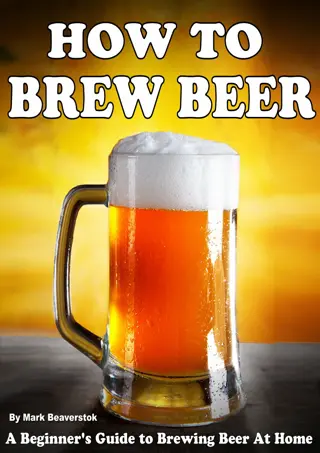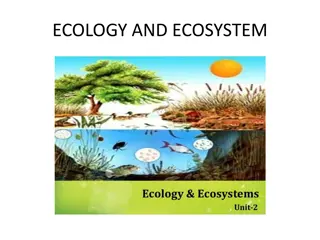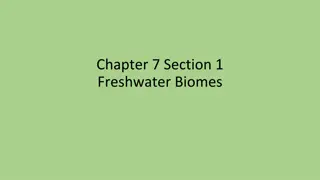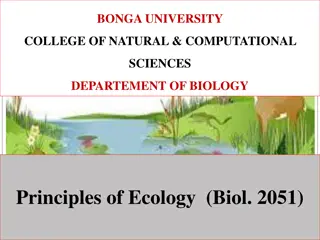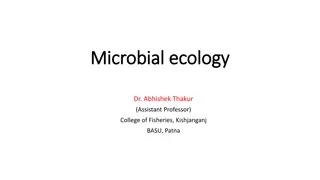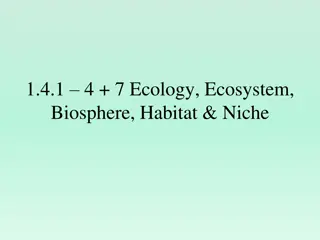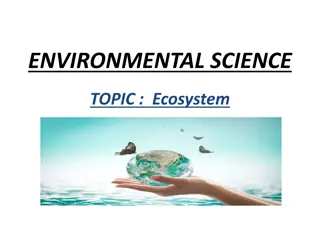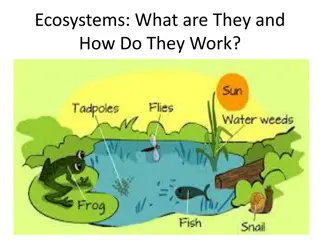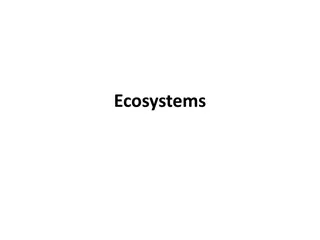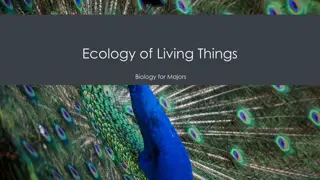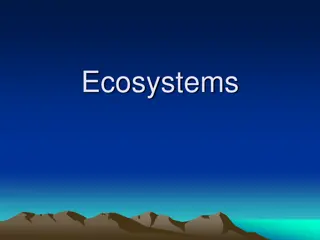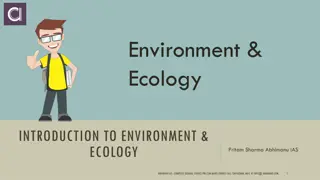Understanding Ecosystems: A Beginner's Guide to Ecology
Explore the fascinating world of ecosystems with Mrs. Hart in this informative biology lesson. Discover the components of ecosystems, from biotic to abiotic factors. Learn how energy flows through the ecosystem, with autotrophs producing energy and heterotrophs consuming it. Identify different types of consumers like herbivores, carnivores, omnivores, decomposers, and scavengers. Delve into the critical role each organism plays in maintaining balance within ecological communities.
Download Presentation

Please find below an Image/Link to download the presentation.
The content on the website is provided AS IS for your information and personal use only. It may not be sold, licensed, or shared on other websites without obtaining consent from the author. Download presentation by click this link. If you encounter any issues during the download, it is possible that the publisher has removed the file from their server.
E N D
Presentation Transcript
Ecology: The Study of Ecosystems Mrs. Hart Biology
What is an Ecosystem? An ecosystem includes all the living and non-living things in a given area Biotic Factors: Living Things Ex: Abiotic Factors: Non-Living Things Ex:
How does the ecosystem get energy? sun-soho011905-1919z SUNFLOWER%25202
Autotrophs Living things that can make their own food Green Plants that have chlorophyll are able to convert the sun s energy to chemical energy (food) This process is called photosynthesis Autotrophs are also known as Producers because they produce the energy for the ecosystem
Weve got to EAT!!! Heterotrophs: Living things that are NOT able to make their own energy; we must eat other living things for energy Heterotrophs are also known as Consumers because they consume other living things for energy But what kind of living things do we eat???
Herbivores Eat only plants!!! Larva10 Chipmunk2
Carnivores Eat only meat Amur GreatWhite carnivore
Omnivores Eat both plant and animal material Black%2520Bear%2520Eating eating brown_bear
Is there another type of feeder? Decomposers: Live off of dead living things and wastes best_in_show bacteria%2520pseudomonas%2520aeruginosa
Scavengers Consumers that eat animals that are already dead hooded%2520vulture,%2520arba%2520minch lobster
How can we organize the different types of feeders? Food chain- A diagram of what eats what Trophic Levels- A name for the feeding levels within a food chain Producers, Primary Consumers, Secondary Consumers, Tertiary Consumers, Decomposers
Food Webs Many interconnected food chains within an ecosystem Can be very complicated
Quick Quiz: 1. What only eats plants? 2. Who always starts the food chain? 3. Who eats plants AND animals? 4. Who only eats animals? 5. How is a Food Web different from a Food Chain?
Quick Quiz, cont. 6. Who eats EVERYBODY when they re dead? 7. What do we call producers (like plants) who make their own food? 8. What is the other name for consumers? 9. What is the name for living things in the environment? 10. What is the name for non-living things in the environment?
Matter is recycled How is matter recycled? It moves from the producers, to the consumers, through the food web Then it is broken down by decomposers Then it is taken up as nutrients by producers What is recycled? Carbon, Nitrogen, Phosphorus, Sulfur Many more!!!!!!!
What about energy??? Energy moves through the food chain, from producers to consumers to decomposers Where does the energy come from??? Is energy recycled? What is the Law of Conservation of Energy aka The First Law of Thermodynamics
Energy Cannot be Created or Destroyed!!!
However, Energy is NOT recycled Answer: it is changed from one form to another.
Where does the energy go? Most of the energy at each trophic level is used by the living things to conduct their metabolism, in hunting/killing/consuming food, and in other life activities Not all living material is consumed, ex: bones, bark, etc. These parts will be decomposed So where does this energy go?
The Law of 10% At each trophic level, 90% of the available energy is used, with most of it being lost as heat to the atmosphere. Only 10% of the energy at each level is available to the next trophic level So if a producer has 10,000 Calories (or kilocalories) of energy, how much energy would each level after that have?
Energy Can also be measured in Joules (J)
What does this mean for higher level consumers? There s less energy That means there are lower numbers of higher level consumers, and higher levels of producers and lower level consumers What will happen to an ecosystem if all of the producers are killed? (Think deforestation, forest fire, drought, etc)
Symbiosis Living together -Two different species
Parasitism Not symbiotic Causes harm to host A tapeworm in a person or animal intestines
Mutualism Both organisms derive mutual benefit 70380654xFqqms_fs tickbirds and rhinos
Commensalism Only one member benefits The other member: no benefit/ no harm Whale and barnacles Barnacle: gets place to live/feed. Whale: no harm/no benefit http://t2.gstatic.com/images?q=tbn:jpxKQJGqs5jn7M:http://www.scienceline.org/wordpress/wp-content/uploads/2010/03/whalebarnacles_orig-640x480.jpg



